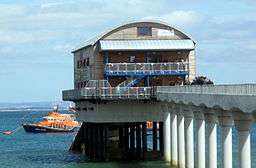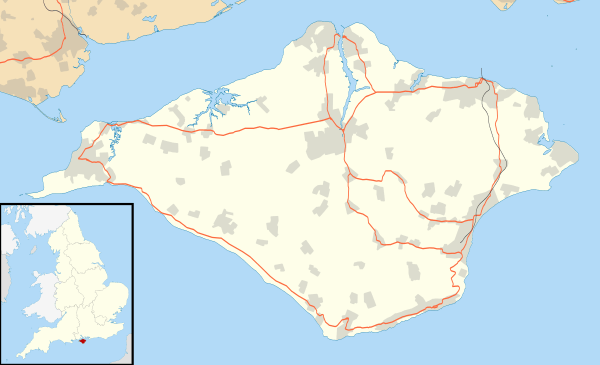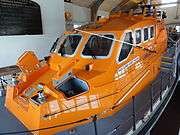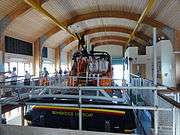Bembridge Lifeboat Station
| Bembridge Lifeboat Station | ||
| RNLI Lifeboat station | ||
 Bembridge Lifeboat Station | ||
|
||
| Country | England | |
|---|---|---|
| County | Isle of Wight | |
| Region | South East England | |
| Village | Bembridge | |
| Location | Lane End, Bembridge, Isle of Wight, PO35 5TD | |
| - coordinates | 50°41′24.7″N 1°04′13.7″W / 50.690194°N 1.070472°WCoordinates: 50°41′24.7″N 1°04′13.7″W / 50.690194°N 1.070472°W | |
| Style | Boathouse built on piles | |
| Material | Concrete and Steel | |
| Founded | 1867 | |
| Owner | Royal National Lifeboat Institution | |
| For public | classed as a Discover[1] station by the RNLI | |
 Location of Bembridge Lifeboat station
within Isle of Wight | ||
Bembridge Lifeboat Station is an RNLI[2] station located in the village of Bembridge in the English county and island of the Isle of Wight in the United Kingdom.[3]
Location
The station is located on the eastern approaches to the Solent Estuary and is south of the area of the Solent known as Spithead. The station is on one of the busiest shipping lanes in United Kingdom waters, used by over 100,000 commercial ships per annum.
The main boathouse stands away from the shore on a piled platform with slipway, and is linked to the shore by means of a gangway. The station operates two lifeboats. The All weather lifeboat is a Tamar-class and is called RNLB Alfred Albert Williams (ON 1297) and has been at the station since 2010. The second lifeboat is an Inshore lifeboat and is a D-class (IB1) and is called RNLB Dorothy Beatrice May Gorman (D-649). The inshore lifeboat is kept in a boathouse on the shore next to the pier head of the main boathouse gangway.
History
The first lifeboat service began at Bembridge in 1867.[4] A boathouse was built at Lane End at a cost of £165, and the first lifeboat was launched from here by means of a carriage. The first lifeboat on station was a self-righting pulling lifeboat and was 32 feet 0 inches (9.75 m) and 7 feet 6 inches (2.29 m) in beam. She was paid for by the subscriptions of the citizens of Worcester and was named RNLB City of Worcester.[5] The first boathouse was enlarged between 1902 and 1903 and was used right up until 1922.[4]
By 1922 the RNLI realised that given Bembridge's location that the station required a motor lifeboat to replace the old pulling lifeboat. This change-over would require the construction of a new boathouse. To launch a motor lifeboat the RNLI had to build a concrete pier some 250 yards in length from the shore to the outer ridge of rocks. At the seaward end of the pier, a platform was constructed on concrete piles, with a concrete, timber and steel launching slipway directly into deep water outside the reef. Following the construction of the new facility, a single-screw motor Lifeboat of the self-righting type arrived at the station. This lifeboat was christened and launched by a lady of the donor's family. The lifeboat was named RNLB Langham (ON 676)[6][7] after the gentleman who had presented the legacy. The improvements made to the station at this time made Bembridge the most state of the art station in the country and gave the crew the capability to be at sea in just 14 minutes. The new motor lifeboat also extended the range of the station, which in turn led to the closure of the neighbouring stations of Brook[8] and Brighstone.[9]
Further improvements to the station were undertaken at the station in 1939. Work was carried out on the boathouse to enlarge it capacity to accommodate a new Watson-class Twin screw motor lifeboat. The new lifeboat was the RNLB Jesse Lumb (ON 822)[10][11] which arrived on station and was christened and was dedicated by the Right Rev. Lord Bishop of Salisbury, Dr. Neville Lovett, D.D. on 21 July 1939. The new Lifeboat was funded from the legacy presented to the Institution by a gentleman of London and Leicester named Lumb. Jesse Lumb's service at Bembridge ended in 1970. She then spent some years in the RNLI relief fleet before being acquired by the Imperial War Museum and placed on display at the museum's branch at Duxford in Cambridgeshire. She became part of the National Historic Fleet in August 1999, with certificate number 1759.[11]
In 1964[4] the RNLI established an inshore lifeboat service which became part of the Bembridge station and utilised the 1867 boathouse at Lane end to house the D-class ILB.
The boathouse was once again altered and improved to accommodate a new lifeboat. The new lifeboat was the Solent-class RNLB Jack Shayler and the Lees (ON 1009)[12] which served on station from 1970 until 1978.
In 1987 the station was allocated a new Tyne-class lifeboat. The boathouse once again had to be altered to accommodate the bigger boat. This re-development included the installation of new fuel storage tank. RNLB Max Aitken III (ON 1126)[13] was on the station from 1987 until 2010. In 1989 work was done on the slipway to extend the toe.
In 1994[4] further improvements were made to the station with vital major repairs made to the slipway. The old station used for the inshore boat at lane end had work carried out in the roof space to create space for improved crew facilities.[4]
2009 major re-development
In 2009 a new lifeboat was to be placed on station which needed major re-development of the offshore boathouse which would involve the building of a completely new boathouse.[14][15] The Bembridge station launched an appeal to the public with the aim of raising £1 million towards the projected £10 million required for the station and new lifeboat. Demolition of the old station began in May 2009. The old Tyne-class Max Aitken III was retired to the relief fleet and the station was allocated the Mersey-class RNLB Peggy & Alex Caird (ON 1124) to cover the station whilst the new station was built. The Peggy & Alex Caird was stationed just outside the harbour at the Point in Bembridge and launched across the beach by a semi-submersible Talus MB-H (T100) fully tracked tractor. The new station was the third purpose built house and slipway specifically built to facilitate the Tamar-class lifeboat with the first built at Cromer. The architects were Alan Culshaw Architects with Opus[16] and Hoare Lea[17] carrying out the engineering design for the station. The design brief for this station was to achieve a facility which would allow the lifeboat to reach 95% of casualties within 30 minutes of launch, at virtually any point within 50 miles of Bembridge. The 160metre long elevated walkway which would provide access to the offshore station was engineered by Opus.[16] The station facilities on the shore at Lane End were also re-constructed at this time with the work carried out by Stoneham Construction.[18] The work carried out required that parts of the building which dated back to the nineteenth century original boathouse were to be kept. These older sections of the boathouse were carefully protected and preserved whilst the new building was gradually erected all around them. Work carried out included the installing of a modern state-of-the-art deep bored ground source heat pump, and a new piled foundation for the new inshore lifeboat hall. Within the new building, changing rooms for the lifeboat men were installed and a training room was completed on the first floor above, together with an office. The station was also provided with a new souvenir shop.
The new boathouse, station and gangway was completed by October 2010 and cost £7,650,000. On 27 September 2010 the new Tamar-class lifeboat was deployed to the new station. It is called RNLB Alfred Albert Williams (ON 1297)'[19] and it became operational in the early days of October.
Notable rescues
1916 RNLB Queen Victoria
On 3 February 1916 the SS Empress Queen became stranded in thick fog on the Ring Rocks, Bembridge Ledge, off the Foreland at the eastern extremity of the Isle of Wight. The ship was returning to Southampton from Le Havre with 1,300 men and a large quantity of ammunition on board. In foul weather, and the fog shutting down visibility to just a few yards, she ran ashore at 05:00hrs on the Ring Rocks.[20] She ran well up on to them on a rising tide, the wind was light, and the sea was calm. A destroyer was used to take off the troops; the crew remained on board as efforts were made to pull the vessel off. It was not expected to be a difficult task, but it proved impossible. The weather changed in a matter of hours and a gale blew up. The Bembridge lifeboat RNLB Queen Victoria was launched to service when the tide was favourable and arrived at the stricken vessel but was unable to anchor. After a considerable struggle the lifeboat was able to retrieve a line thrown from the wrecked ship. During the struggle with the rope the Bembridge Coxswain John Holbrook sustained a severe injury to his hand but even with this difficulty he managed to make four trips to the wreck lifting 110 people and the ship's cat and dog and landing them to shore safely. During these rescues the Queen Victoria was badly damaged on the rocks and on the last trip was in a water-logged condition. The nine remaining people aboard the wreck were taken off by a fishing boat. For his part in the service John Holbrook was awarded an RNLI silver medal.[4][21]
1919 RNLB Queen Victoria
.jpg)
On the morning of 28 August 1919 there was heavy rain in a strong southerly gale. Into very heavy seas the lifeboat Queen Victoria was sent out on a service. An American ship called the USS Wakulla (ID-3147)[22] of Los Angeles, had been driven ashore on to a shoal at West Wittering, near Chichester. At the scene the lifeboat noted that the Wakulla had been taken in to tow by a government tug which had progressed to the windward side of the ship. In heavy seas the Queen Victoria with great courage and skill got alongside the vessel and was able to take of 13 men of the crew, and landed them safely to land. The lifeboat then returned to the Wakulla and stood by until 4:00 am. By that time the weather had moderated and the wind had shifted. By this time Coxswain John Holbrook had been at the helm for 19 hours. For his part in this rescue he was awarded an RNLI silver medal.[23]
1940 RNLB Jesse Lumb
On 29 January 1940 there was an easterly blizzard with heavy seas in the English Channel. Following a distress call it was in to these conditions that the Watson-class lifeboat RNLB Jesse Lumb (ON 822) put out to sea at 5:20pm in the afternoon. She was directed to search the area of Man's Fort just off Selsey. Failing to find anything, Coxswain Harry Gawn was re-directed to search between Ryde and Seaview on the Isle of Wight. after some time he located a vessel but it was found not to be in any danger. The lifeboat was then directed to head for Chichester Bar located just outside Chichester Harbour. The lifeboat attended HMT Kingston Cairngorm[24] which was found to be taking on water and flooding fast. In a service which involved the lifeboat making several approaches to the stricken vessel, she took 21 of her crew off and landed them all safely in Portsmouth. The lifeboat had then been at sea for 14 hours with coxswain Gawn at the helm all that time. The weather had been so bad that the crew had to clear the deck of thick ice at the end of the service. For his part in the service Coxswain Harry Gawn was awarded an RNLI bronze medal.[25]
1941 RNLB Jesse Lumb
The Bembridge lifeboat Jesse Lumb was launched following a call from the coastguard on 8 August 1941.[26] There was a report of an aircraft down 10 miles to the south of the Bembridge station. The lifeboat was guided through very rough seas by an aircraft which circled overhead but soon headed off. the lifeboat searched but found nothing. The lifeboat did however find the Royal Air Force rescue launch HSL 116. The vessel was in some distress and was disabled and flying a distress single. The launch which had been patrolling the channel during heavy fighting in the skies above, and had herself come under attack by German Aircraft. One of the crew, the Radio Operator, had been killed and another was suffering from sever wounded. The launch had had its propeller fouled by rope and was drifting. the Jesse Lumb managed to get a line aboard and took the vessel into tow. The seriously wounded crew man and the launch were taken directly to the Hospital at Haslar in Portsmouth by the lifeboat. The lifeboat and her crew finally returned to their station after being at sea for 14 hours.
Fleet
All Weather lifeboats
| Dates in service | Class | ON | Op. No. | Name |
|---|---|---|---|---|
| 1922–1939 | 40ft Self-righter | 676 | Langholm | |
| 1939–1970 | 46ft Watson-class | 822 | Jesse Lumb | |
| 1970–1987 | Solent-class | 1009 | 48-006 | Jack Shayler and the Lees |
| 1987–2010 | Tyne-class | 1126 | 47-018 | Max Aitken III |
| 2010–present | Tamar-class | 1297 | 16-17 | Alfred Albert Williams |
Inshore lifeboats
| At Bembridge | Class | Op No | Name |
|---|---|---|---|
| 1964 | D-class (RFD PB16) | D-8 | Unnamed |
| 1965–1967 | D-class (RFD PB16) | D-18 | Unnamed |
| 1967–1968 | D-class (RFD PB16) | D-144 | Unnamed |
| 1969–1971 | D-class (RFD PB16) | D-24 | Unnamed |
| 1971–1975 | D-class (RFD PB16) | D-101 | Unnamed |
| 1976–1987 | D-class (Zodiac III) | D-244 | Unnamed |
| 1987–1996 | D-class (EA16) | D-353 | Unnamed |
| 1996–2005 | D-class (EA16) | D-503 | Criddy and Tom |
| 2005–2015 | D-class (IB1) | D-649 | Dorothy Beatrice May Gorman |
| 2015–present | D-class (IB1) | D-778 | Norman Harvey |
Gallery
|
Neighbouring Station Locations
 |
Gosport and Fareham Lifeboat Station | Portsmouth Lifeboat Station |
Hayling Island Lifeboat Station |
 |
| Ryde Lifeboat Station | |
Selsey Lifeboat Station | ||
| ||||
| | ||||
| Sandown and Shanklin Independent Lifeboat Station | English Channel | English Channel |
References
- ↑ "Visiting stations". Explanation of the visitor-classification of the RNLI stations. The RNLI – copyright RNLI 2014. Retrieved 5 March 2014.
- ↑ "The RNLI Bembridge Lifeboat Station website". Home page of station website – RNLI. 2014 RNLI. Retrieved 6 March 2014.
- ↑ OS Explorer Map OL29 – Isle of Wight, Folded Map. Publisher:Ordnance Survey; B2 edition (17 March 2008). ISBN 978 0319240151
- 1 2 3 4 5 6 For Those in Peril – The Lifeboat Service of the United Kingdom and the Republic of Ireland, Station by Station. Author: Leach, Nicholas. Publisher: Silver Link Publishing Ltd, First Issue 1999. Work:Part 2, South Coast of England – Eastbourne to Weston-super-Mare, Page 78, Bembridge. ISBN 1 85794 129 2
- ↑ "Early History – Bembridge lifeboat station.". Disription of the early history of the station and its lifeboats. 2013 Bembridge Lifeboat, [email protected], Website by Neo-Archaic. Retrieved 6 March 2014.
- ↑ "RNLB Langham". Details of the lifeboat on the historic Ship Register. The National Historic ships Register – The official voice of historic ships in the UK. Retrieved 6 March 2014.
- ↑ "Queen Victoria Lifeboat – Other Restoration Projects". Photos and text about the restoration work to the RNLB Langham. The Isle of Wight Historic Lifeboat Trust. Retrieved 6 March 2014.
- ↑ "Brook Village History – Brook Lifeboat". History of the brook lifeboat station. Brook Village History 2014. Retrieved 6 March 2014.
- ↑ "Brighstone Bay History". Photograph of the old Lifeboat house and reference to the station. Grange Farm History. Retrieved 6 March 2014.
- ↑ "Ship, Lifeboat 'Jesse Lumb', British (MAR 557)". Imperial War Museum Collection Search. Imperial War Museum. Retrieved 6 March 2014.
- 1 2 "Jesse Lumb". National Register of Historic Vessels. National Historic Ships. 2011. Retrieved 6 March 2014.
- ↑ "Solent Class Lifeboats". List of RNLI Solent Lifeboats with service dates and Details. navynuts.com. Retrieved 6 March 2014.
- ↑ "Tyne Class Lifeboats". List of RNLI Tyne class Lifeboats with service dates and Details. navynuts.com. Retrieved 6 March 2014.
- ↑ "New Bembridge RNLI lifeboat station one step nearer after planners give the green light". RNLI website giving information on the planning process. 2014 RNLI. Retrieved 7 March 2014.
- ↑ "Isle of Wight County Press online – New Station on its way". News report on the building of a new lifeboat station at Bembridge. 2014 Isle of Wight County Press. Retrieved 7 March 2014.
- 1 2 "Bembridge Lifeboat station – Opus". Reference to the construction of the 160metre long elevated walkway. 2014 Opus International – consulting Ltd. Retrieved 7 March 2014.
- ↑ "Hoar Lea – Lifeboat station receives highest honour at ICE South Awards". Lifeboat Station Design wins award. 2014 Hoare Lea – consulting engineers RNLI. Retrieved 7 March 2014.
- ↑ "Stonham Construction – Lifeboat Station, Bembridge". Description of the work carried out by Stoneham Construction. 2014 Stoneham Construction. Retrieved 7 March 2014.
- ↑ "Tamar-class 16.25-metre Lifeboat". List of Tamar-class lifeboats, includes ON-1297. Lifeboat World On-Line 2014. Retrieved 11 March 2014.
- ↑ "SS Empress Queen". Description and wreck details for the SS Empress Queen. 2014, Wrecksite.eu. Retrieved 6 March 2014.
- ↑ Lifeboat Gallantry – RNLI Medals and how they were won. Author: Cox, Barry. Published by: Spink & Son Ltd. Work: Page 236 – HOLBROOK John, Coxswain, Bembridge Lifeboat. ISBN 0907605893
- ↑ "USS Wakulla (ID # 3147) – 1918–1919 – Originally and later S.S. Wakulla (American Freighter, 1918).". Details of the ship and her service. 2014 Naval Historical Center. Retrieved 8 March 2014.
- ↑ Lifeboat Gallantry – RNLI Medals and how they were won. Author: Cox, Barry. Published by: Spink & Son Ltd. Work: Page 245/246 – HOLBROOK John, Coxswain, Bembridge Lifeboat. ISBN 0907605893
- ↑ "HMS Kingston Cairngorm". Details and description of HMS Kingston Cairngorm. 1995–2014 Guðmundur Helgason. Retrieved 6 March 2014.
- ↑ Lifeboat Gallantry – RNLI Medals and how they were won. Author: Cox, Barry. Published by: Spink & Son Ltd. Work: Page 281 – GAWN harry James, Coxswain, Bembridge Lifeboat. ISBN 0907605893
- ↑ Shot Down And In The Drink – RAF and Commonwealth aircrews saved from the sea 1939–1945. Author:Pitchfork, Graham. Publisher:The National Archives – Date: 2005. work: Chapter 7, The first three years, Page 81, Jesse Lumb service to RAF's HSL 116. ISBN 1 903365 87 2




